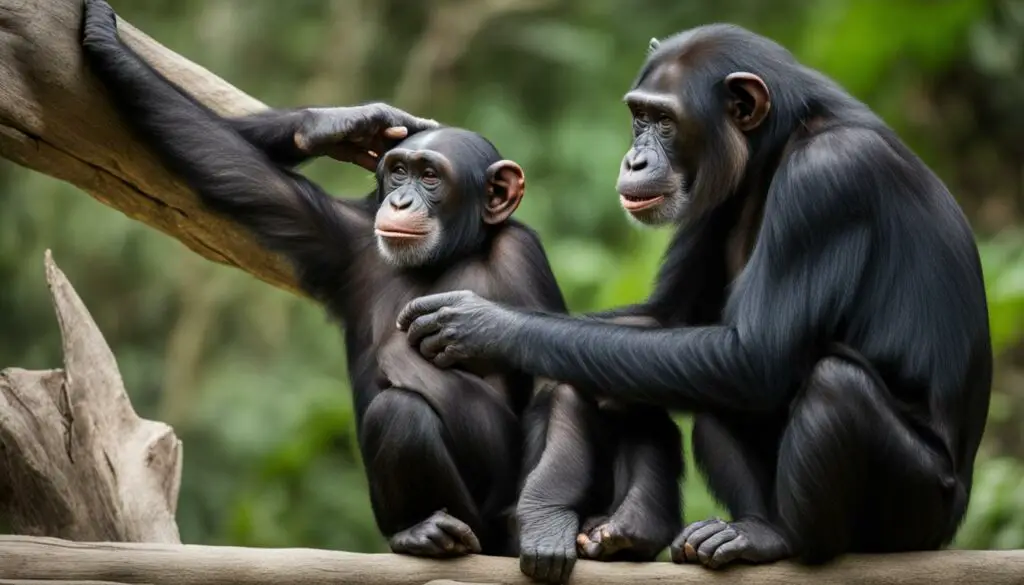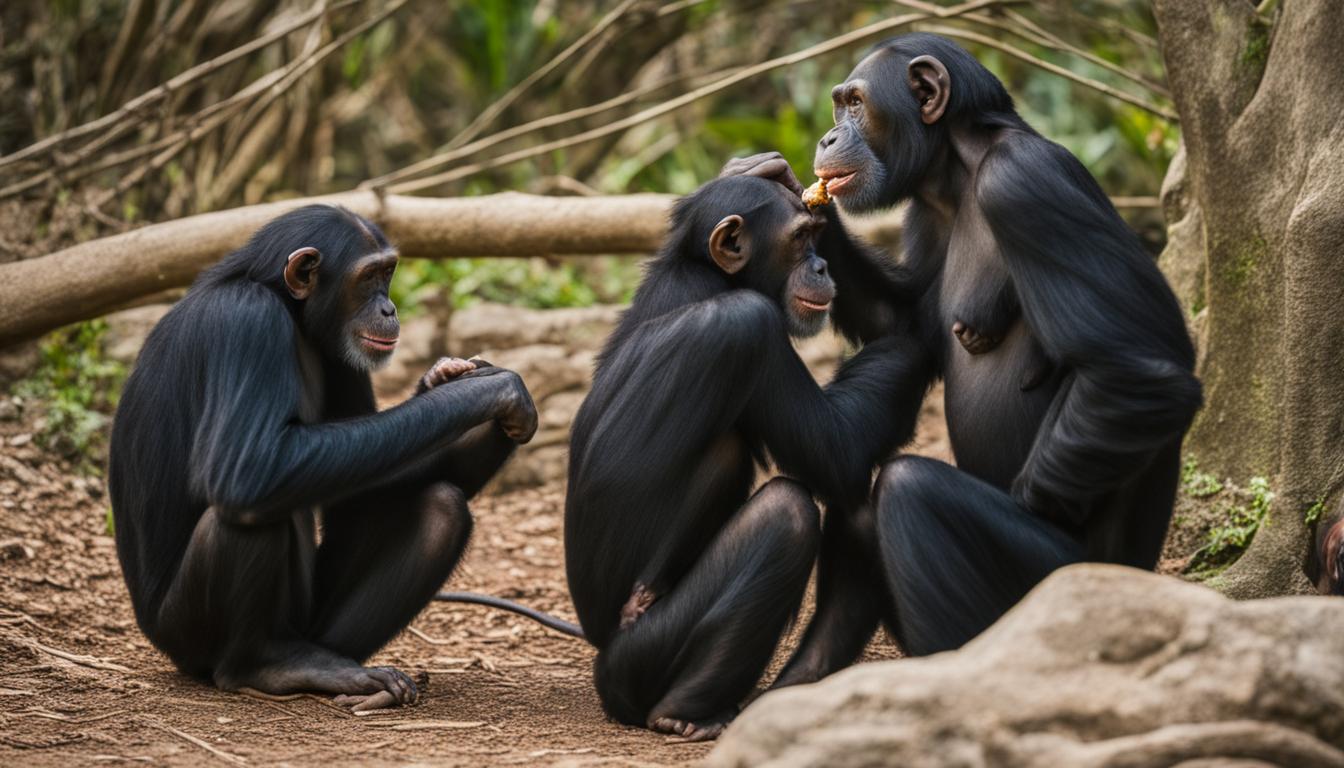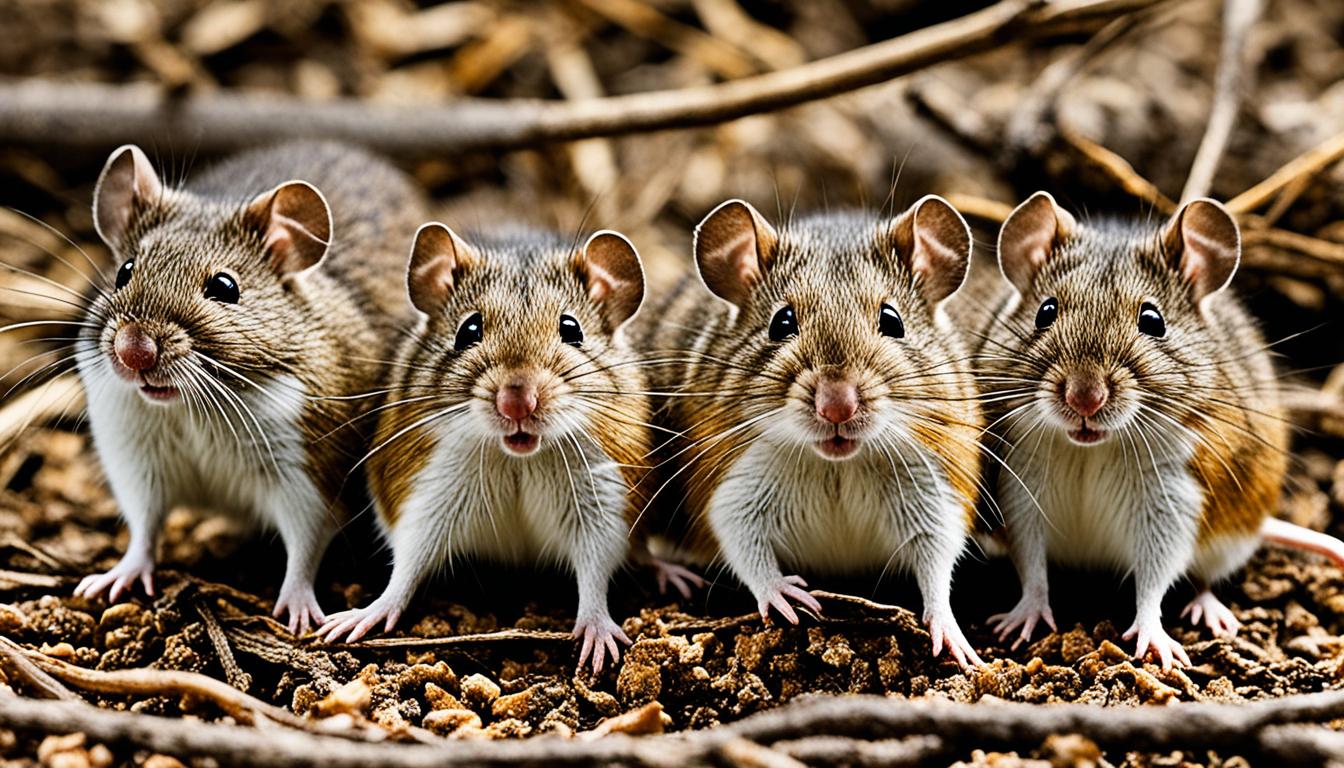Chimpanzees, our closest relatives in the animal kingdom, have a fascinating way of communicating with each other in the wild. Through their use of gestures, facial expressions, and vocalizations, they are able to convey emotions, share information, and coordinate group activities. This form of primate communication provides valuable insights into the complexities of animal language and non-human communication.
Studies conducted on both wild chimpanzees and captive groups have revealed the intelligence and understanding behind their communication. While their repertoire of sounds and gestures is limited compared to humans, chimpanzees’ advanced social cognition allows them to use these signals effectively. They mentally model the social dynamics of their group, remember dominant individuals, and anticipate the actions and intentions of others.
Chimpanzee communication plays a crucial role in their social interactions and group dynamics. By using a combination of gestures, vocalizations, and facial expressions, they establish and maintain social relationships, display emotions, and coordinate activities. Their ability to interpret the intentions and emotions of their group members highlights the importance of communication in chimpanzee society.
The complexity of chimpanzee communication goes beyond simple calls and cries. They possess a rich repertoire of gestures, vocalizations, and facial expressions, which they use to convey messages and engage in social interactions. They can direct others’ attention, request support, and indicate their emotional state through specific gestures. These observations demonstrate the sophisticated level of communication found in chimpanzees.
The study of chimpanzee communication has also provided insights into the origins and development of human language. Through sign language studies and communication experiments, researchers have shown that chimpanzees can learn to use signs or symbols to represent lexical concepts and convey their thoughts and desires. This indicates the potential for language-like abilities in non-human primates.
By studying communication in chimpanzees, researchers gain valuable insights into the evolution of language and social cognition in humans. Chimpanzees’ intentional communication, understanding of social dynamics, and engagement in cooperative behaviors provide evidence for the gradual development of communication skills in our lineage.
In conclusion, chimpanzee communication in the wild is a remarkable phenomenon. Through their use of gestures, facial expressions, and vocalizations, chimpanzees convey information and social cues, showcasing their intelligence and social complexity. By studying chimpanzees’ communication abilities, we can gain insights into the origins and development of human language, as well as the cognitive capacities necessary for complex social interactions.
The Role of Communication in Chimpanzee Society
Chimpanzee communication plays a crucial role in their social interactions and group dynamics. By using gestures, vocalizations, and facial expressions, chimpanzees are able to establish and maintain social relationships, display emotions, and coordinate activities. These communication signals are not only instinctive but also involve a level of intelligence and understanding of the social world around them. Chimpanzee behavior studies have shown that they can mentally model the social dynamics of their group, remember dominant individuals, and anticipate the actions and intentions of others. This level of communication and social cognition sets chimpanzees apart from other highly social species.
In their natural habitat, chimpanzees use a variety of vocalizations to convey different messages. They have specific calls for warning others about predators, expressing excitement or distress, and coordinating group movements. For example, a high-pitched scream can alert the rest of the group to the presence of a potential threat, while a soft pant-hoot can serve as a greeting or a way to locate other members. These vocalizations, combined with facial expressions and body postures, allow chimpanzees to effectively communicate their intentions and emotions, fostering cooperation and social cohesion within the group.
Furthermore, gestures play a significant role in chimpanzee communication. They use hand movements, head nods, and body postures to convey different messages, such as directing attention, requesting support, or establishing dominance. For instance, a chimpanzee may extend an arm to beg for food or pat the ground to invite others to play. These gestures are not only understood by other chimpanzees but also have cultural variations within different populations, indicating a level of learning and social transmission.
Overall, the communication abilities of chimpanzees are complex and sophisticated, reflecting their intelligence and social complexity. By studying their communication patterns and behaviors, researchers gain valuable insights into the evolution of language and the cognitive capacities necessary for complex social interactions. Chimpanzee communication not only showcases the richness of non-human primate communication but also highlights the interconnectedness of humans and our closest relatives in the animal kingdom.
| Communication Signal | Description |
|---|---|
| Pant-hoot | A loud, rhythmic vocalization used to communicate over long distances and locate other group members. |
| Begging Gesture | Extending an arm or reaching out towards others to request food or attention. |
| Play Invitation | Patting the ground or performing a playful body posture to invite others to engage in play. |
| Threat Display | Standing upright, showing teeth, and making aggressive vocalizations to establish dominance or deter potential threats. |
The Complexity of Chimpanzee Communication
Chimpanzee communication is a fascinating subject that goes beyond simple calls and cries. These intelligent creatures possess a rich repertoire of gestures, vocalizations, and facial expressions, which they use to convey messages and engage in social interactions.
Observations of both wild chimpanzees and those in captive groups have revealed that chimpanzees employ specific gestures to direct others’ attention, request support, or indicate their emotional state. They can even develop their own unique signals and understand the intentions and emotions of their group members.
Chimpanzee communication is a sophisticated system that highlights their intelligence and social complexity. By studying their communication abilities, researchers have gained valuable insights into the cognitive capacities necessary for complex social interactions in both humans and non-human primates.
The Complexity of Chimpanzee Gestures
One aspect of chimpanzee communication that showcases their intelligence is their use of gestures. They have been observed using a wide range of gestures to convey different meanings. For example, they may extend their arm to request food or reach out with an open hand to initiate play. These gestures can be highly specific and context-dependent, demonstrating their ability to communicate with precision.
Vocalizations and Facial Expressions
Chimpanzees also communicate through vocalizations and facial expressions. They have a repertoire of calls that can vary depending on the situation, such as alarm calls to warn others of danger or greeting calls to establish social bonds. Their facial expressions, including smiles or displays of aggression, are used to convey emotions and intentions to other chimpanzees.
| Chimpanzee Communication Signals | Description |
|---|---|
| Gestures | Chimpanzees use a variety of gestures to communicate, including reaching out for food, presenting objects, or displaying aggression. |
| Vocalizations | Chimpanzees have a repertoire of vocal calls, such as hoots, screams, and grunts, which they use to convey different messages and emotions. |
| Facial Expressions | Facial expressions, such as smiles, grimaces, or bared teeth, play an important role in chimpanzee communication, conveying emotions and social information. |
| Unique Signals | Chimpanzees can also develop their own unique signals within specific group or family contexts, allowing for more nuanced communication. |
Chimpanzee communication is a complex and intricate system that highlights their intelligence and social abilities. It provides valuable insights into the evolution of communication and social cognition in both non-human primates and humans alike. By studying the complexity of chimpanzee communication, researchers can gain a deeper understanding of our own communication systems and the cognitive processes that underlie them.

The Connection Between Chimpanzee Communication and Language
The study of chimpanzee communication has shed light on the intriguing connection between primate communication and the development of language. Through a series of animal communication studies and primate research, scientists have made significant discoveries about the potential for language-like abilities in non-human primates.
A notable example of this is the use of sign language by chimpanzees. Through experiments and training, researchers have shown that chimpanzees can learn to use signs or symbols to represent lexical concepts and convey their thoughts and desires. This fascinating ability demonstrates the potential for symbolic communication in chimpanzees, a skill that forms the foundation of human language.
Chimpanzees’ ability to use symbolic communication and adapt it to their social context demonstrates the potential for language-like abilities in non-human primates.
Furthermore, studies have revealed that chimpanzees can comprehend and produce novel phrases, understand vocal English, and even transmit their signing skills to the next generation. While there are ongoing debates about the extent of their understanding of syntax and the complexities of human language, the fact that chimpanzees can successfully use symbolic communication suggests that they possess cognitive capacities necessary for language development.
The exploration of chimpanzee communication and its connection to language has provided valuable insights into the origins and evolution of human language. By understanding the capabilities of our closest relatives in the animal kingdom, researchers can gain a deeper understanding of the gradual development of communication skills and the cognitive abilities required for complex social interactions.
| Chimpanzee Communication | Language Development |
|---|---|
| Chimpanzees use gestures, facial expressions, and vocalizations to communicate. | Human language involves the use of words, grammar, and syntax to convey meaning. |
| Chimpanzees can learn to use signs or symbols to represent concepts. | Human language includes a vast vocabulary of words and their associated meanings. |
| Chimpanzees can comprehend and produce novel phrases. | Human language allows for the creation of infinite new sentences. |
| Chimpanzee communication is primarily non-verbal. | Human language involves both verbal and non-verbal elements. |
The Evolutionary Significance of Chimpanzee Communication
Chimpanzee communication holds immense evolutionary significance, offering valuable insights into the origins and development of language and social cognition in humans. By studying the complex communication systems of our closest relatives, researchers can gain a deeper understanding of the cognitive capacities necessary for complex social interactions and the gradual development of language skills in our lineage.
Chimpanzees’ ability to communicate intentionally and understand the social dynamics of their group highlights their highly intelligent and sophisticated nature. Through a rich repertoire of gestures, vocalizations, and facial expressions, chimpanzees are able to convey emotions, share information, and coordinate group activities. This complex communication system demonstrates the potential for language-like abilities in non-human primates and sheds light on the role of communication in human cooperation, culture, and the formation of complex societies.
Animal language studies and primate research have shown that chimpanzees can learn to use signs or symbols to represent lexical concepts and convey their thoughts and desires. While there are ongoing debates about the extent of their understanding of syntax and the complexities of human language, chimpanzees’ use of symbolic communication and their ability to adapt it to their social context are compelling indicators of their communicative abilities.
| Evolutionary Implications of Chimpanzee Communication | Insights |
|---|---|
| 1. Development of Language | Chimpanzee communication provides clues about the gradual development of language skills in humans. |
| 2. Cognitive Capacities | Studying chimpanzee communication sheds light on the cognitive capacities necessary for complex social interactions. |
| 3. Human Cooperation and Culture | Chimpanzee communication hints at the role of language in human cooperation, culture, and the formation of complex societies. |
“By studying chimpanzee communication, we can gain valuable insights into the evolutionary origins of language and the cognitive capacities needed for complex social interactions.” – Dr. Jane Goodall
Conclusion
Chimpanzee communication in the wild is a fascinating phenomenon that reveals the complexity and intelligence of these remarkable animals. Through their use of gestures, facial expressions, and vocalizations, chimpanzees are able to convey emotions, share information, and coordinate group activities. Their communication abilities go beyond simple calls and cries, involving a rich repertoire of signals that allow them to direct attention, request support, and indicate their emotional state.
Studying chimpanzee communication provides valuable insights into primate communication and the potential for non-human language. By observing our closest relatives, researchers can gain a deeper understanding of the evolutionary origins of language and the cognitive capacities necessary for complex social interactions. Chimpanzees’ ability to understand the social dynamics of their group, engage in cooperative behaviors, and even use symbolic communication demonstrates the gradual development of communication skills in our lineage.
Chimpanzees’ communication abilities also highlight the importance of language in human cooperation, culture, and the formation of complex societies. By unraveling the intricacies of chimpanzee communication, we can gain a better understanding of our own communication systems and the role they play in our social interactions. Overall, the study of chimpanzee communication in the wild provides a fascinating window into the world of non-human communication and its evolutionary significance.
What are the different ways that chimpanzees communicate and display social behaviors in their natural habitat?
Chimpanzees communicate using a variety of methods, including vocalizations, gestures, and facial expressions. They use chimpanzee communication cues such as body language, grooming, and play to establish and maintain social bonds within their groups. These behaviors play a crucial role in their complex social structure and relationships.
FAQ
How do chimpanzees communicate with each other?
Chimpanzees communicate through a variety of gestures, facial expressions, and vocalizations.
What is the role of communication in chimpanzee society?
Communication plays a crucial role in establishing and maintaining social relationships, displaying emotions, and coordinating activities within chimpanzee groups.
How complex is chimpanzee communication?
Chimpanzee communication is sophisticated, involving specific gestures, vocalizations, and facial expressions that convey messages and engage in social interactions.
What is the connection between chimpanzee communication and language?
Studying chimpanzee communication provides insights into the origins and development of human language and the cognitive capacities necessary for complex social interactions.
What is the evolutionary significance of chimpanzee communication?
Understanding chimpanzee communication helps us understand the evolution of language and social cognition in humans and the development of complex societies.











